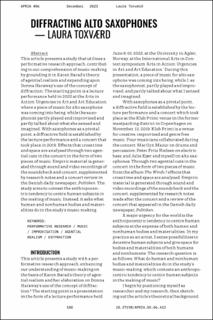| dc.contributor.author | Toxværd, Laura | |
| dc.date.accessioned | 2024-04-10T11:08:18Z | |
| dc.date.available | 2024-04-10T11:08:18Z | |
| dc.date.created | 2023-08-19T17:30:22Z | |
| dc.date.issued | 2023 | |
| dc.identifier.citation | Toxværd, L. (2023). Diffracting alto saxophones. APRIA Journal, 6(6), 98-105. | en_US |
| dc.identifier.issn | 2589-9007 | |
| dc.identifier.uri | https://hdl.handle.net/11250/3125786 | |
| dc.description.abstract | The article unfolds a study with a performative research approach that contributes to our understanding of music making on the basis of Karen Barad’s theory of agential realism and her elaboration on Donna Haraway’s use of the concept of diffraction. The setting off point is a lecture performance held in 2022 at the Arts in Action: Urgencies in Art and Art Education. During this conference presentation, a piece of music for alto saxophone was coming into being, while the saxophonist partly played and improvised and partly talked about what she sensed and imagined. With saxophones as a pivotal point, a diffractive field is established by the lecture performance and a concert which took place in 2019. Through two agential cuts in the concert in the form of two pieces of music, effects that cross time and space are analysed. Empiric material is generated through sound and video recordings of the soundcheck and concert, supplemented by research notes and a concert review in the Danish daily newspaper, Politiken. The study aims to contest the anthropocentric tendency to center human subjects in the making of music. Instead, it asks what human and nonhuman bodies and materialities do in the study’s music making. | en_US |
| dc.language.iso | eng | en_US |
| dc.publisher | ArtEZ University of the Arts | en_US |
| dc.rights | Navngivelse-Ikkekommersiell 4.0 Internasjonal | * |
| dc.rights.uri | http://creativecommons.org/licenses/by-nc/4.0/deed.no | * |
| dc.title | Diffracting alto saxophones | en_US |
| dc.type | Journal article | en_US |
| dc.type | Peer reviewed | en_US |
| dc.description.version | publishedVersion | en_US |
| dc.rights.holder | © 2023 The Author(s) | en_US |
| dc.rights.holder | © 2023 ArtEZ University of the Arts | |
| dc.subject.nsi | VDP::Humaniora: 000::Musikkvitenskap: 110 | en_US |
| dc.source.pagenumber | 98-105 | en_US |
| dc.source.volume | 6 | |
| dc.source.journal | APRIA Journal | en_US |
| dc.source.issue | 6 | |
| dc.identifier.doi | https://doi.org/10.37198/APRIA.05.06.A12 | |
| dc.identifier.cristin | 2168116 | |
| cristin.qualitycode | 1 | |

